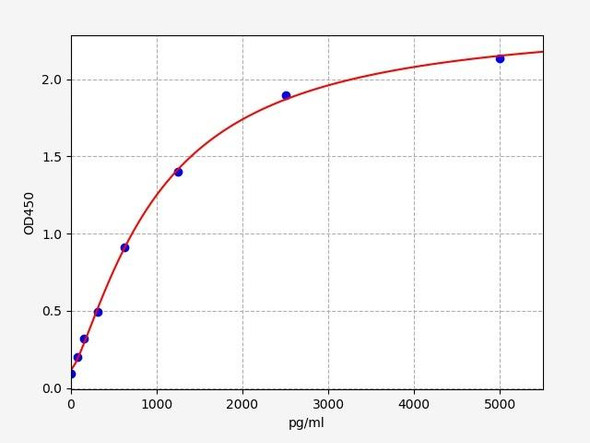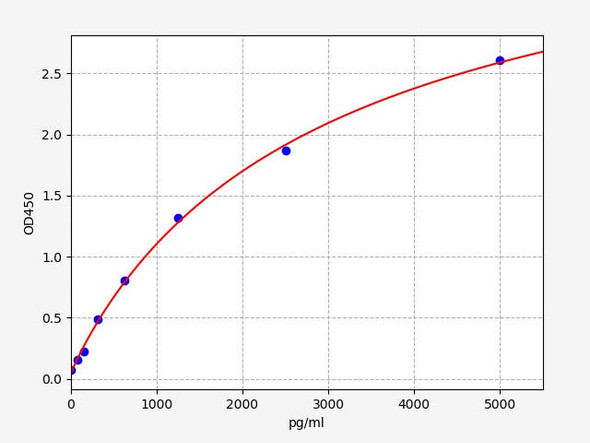Human GAS 6 / Growth arrest-specific protein 6 ELISA Kit
- SKU:
- HUFI00444
- Product Type:
- ELISA Kit
- Size:
- 96 Assays
- Uniprot:
- Q14393
- Sensitivity:
- 37.5pg/ml
- Range:
- 62.5-4000pg/ml
- ELISA Type:
- Sandwich
- Synonyms:
- GAS6, Growth arrest-specific protein 6, AXLLG, AXLLGAXL stimulatory factor, AXSFAXL receptor tyrosine kinase ligand, GAS-6, growth arrest-specific 6
- Reactivity:
- Human
- Research Area:
- Developmental Biology
Description
Human GAS 6/Growth arrest-specific protein 6 ELISA Kit
The Human Gas6 (Growth Arrest-Specific Protein 6) ELISA Kit is designed for the accurate measurement of Gas6 levels in human serum, plasma, and cell culture supernatants. This kit offers high sensitivity and specificity, ensuring consistent and precise results for various research applications.Gas6 is a vital protein that regulates cell growth, survival, and migration, as well as playing a role in processes such as inflammation and coagulation. Dysregulation of Gas6 has been implicated in various diseases, including cancer, autoimmune disorders, and cardiovascular diseases, making it a valuable biomarker for research and potential therapeutic development.
Overall, the Human Gas6 ELISA Kit provides researchers with a reliable tool to study Gas6 levels and its implications in different disease states, ultimately contributing to a better understanding of the role of Gas6 in human health and disease.
| Product Name: | Human GAS 6 / Growth arrest-specific protein 6 ELISA Kit |
| Product Code: | HUFI00444 |
| Size: | 96 Assays |
| Alias: | GAS6, Growth arrest-specific protein 6, AXLLG, AXLLGAXL stimulatory factor, AXSFAXL receptor tyrosine kinase ligand, GAS-6, growth arrest-specific 6 |
| Detection method: | Sandwich ELISA, Double Antibody |
| Application: | This immunoassay kit allows for the in vitro quantitative determination of Human GAS6 concentrations in serum plasma and other biological fluids. |
| Sensitivity: | 37.5pg/ml |
| Range: | 62.5-4000pg/ml |
| Storage: | 4°C for 6 months |
| Note: | For Research Use Only |
| Recovery: | Matrices listed below were spiked with certain level of Human GAS6 and the recovery rates were calculated by comparing the measured value to the expected amount of Human GAS6 in samples. | ||||||||||||||||
| |||||||||||||||||
| Linearity: | The linearity of the kit was assayed by testing samples spiked with appropriate concentration of Human GAS6 and their serial dilutions. The results were demonstrated by the percentage of calculated concentration to the expected. | ||||||||||||||||
| |||||||||||||||||
| CV(%): | Intra-Assay: CV<8% Inter-Assay: CV<10% |
| Component | Quantity | Storage |
| ELISA Microplate (Dismountable) | 8×12 strips | 4°C for 6 months |
| Lyophilized Standard | 2 | 4°C/-20°C |
| Sample/Standard Dilution Buffer | 20ml | 4°C |
| Biotin-labeled Antibody(Concentrated) | 120ul | 4°C (Protect from light) |
| Antibody Dilution Buffer | 10ml | 4°C |
| HRP-Streptavidin Conjugate(SABC) | 120ul | 4°C (Protect from light) |
| SABC Dilution Buffer | 10ml | 4°C |
| TMB Substrate | 10ml | 4°C (Protect from light) |
| Stop Solution | 10ml | 4°C |
| Wash Buffer(25X) | 30ml | 4°C |
| Plate Sealer | 5 | - |
Other materials and equipment required:
- Microplate reader with 450 nm wavelength filter
- Multichannel Pipette, Pipette, microcentrifuge tubes and disposable pipette tips
- Incubator
- Deionized or distilled water
- Absorbent paper
- Buffer resevoir
| Uniprot | Q14393 |
| UniProt Protein Function: | GAS6: Ligand for tyrosine-protein kinase receptors AXL, TYRO3 and MER whose signaling is implicated in cell growth and survival, cell adhesion and cell migration. GAS6/AXL signaling plays a role in various processes such as endothelial cell survival during acidification by preventing apoptosis, optimal cytokine signaling during human natural killer cell development, hepatic regeneration, gonadotropin-releasing hormone neuron survival and migration, platelet activation, or regulation of thrombotic responses. 4 isoforms of the human protein are produced by alternative splicing. |
| UniProt Protein Details: | Protein type:Ligand, receptor tyrosine kinase; Secreted; Secreted, signal peptide Chromosomal Location of Human Ortholog: 13q34 Cellular Component: cytoplasm; endoplasmic reticulum lumen; extracellular region; extracellular space; Golgi lumen Molecular Function:calcium ion binding; caspase inhibitor activity; molecular adaptor activity; phosphatidylserine binding; protein binding; protein tyrosine kinase activator activity; receptor agonist activity; receptor binding; receptor tyrosine kinase binding; voltage-gated calcium channel activity Biological Process: activation of protein kinase B; apoptotic cell clearance; blood coagulation; cell adhesion; cell cycle arrest; cell migration; cell proliferation; cell-substrate adhesion; cellular protein metabolic process; cellular response to starvation; entry of virus into host cell; enzyme linked receptor protein signaling pathway; ER to Golgi vesicle-mediated transport; leukocyte migration; negative regulation of apoptosis; negative regulation of caspase activity; negative regulation of interferon-gamma production; negative regulation of interleukin-1 secretion; negative regulation of interleukin-6 production; negative regulation of protein import into nucleus, translocation; negative regulation of transcription factor activity; negative regulation of transcription, DNA-dependent; negative regulation of tumor necrosis factor production; neuron migration; organ regeneration; peptidyl-glutamic acid carboxylation; peptidyl-serine phosphorylation; phagocytosis; platelet activation; platelet degranulation; positive regulation of cytokine and chemokine mediated signaling pathway; positive regulation of fibroblast proliferation; positive regulation of glomerular filtration; positive regulation of natural killer cell differentiation; positive regulation of peptidyl-serine phosphorylation; positive regulation of phagocytosis; positive regulation of protein amino acid phosphorylation; positive regulation of protein export from nucleus; positive regulation of protein kinase activity; positive regulation of protein kinase B signaling cascade; positive regulation of TOR signaling pathway; post-translational protein modification; protein amino acid phosphorylation; protein kinase B signaling cascade; regulation of growth; signal peptide processing; signal transduction; viral envelope fusion with host membrane; viral genome replication; virion attachment, binding of host cell surface receptor |
| NCBI Summary: | This gene encodes a gamma-carboxyglutamic acid (Gla)-containing protein thought to be involved in the stimulation of cell proliferation. This gene is frequently overexpressed in many cancers and has been implicated as an adverse prognostic marker. Elevated protein levels are additionally associated with a variety of disease states, including venous thromboembolic disease, systemic lupus erythematosus, chronic renal failure, and preeclampsia. [provided by RefSeq, Aug 2014] |
| UniProt Code: | Q14393 |
| NCBI GenInfo Identifier: | 48427995 |
| NCBI Gene ID: | 2621 |
| NCBI Accession: | Q14393.2 |
| UniProt Secondary Accession: | Q14393,Q6IMN1, Q7Z7N3, B3KRQ7, B3KVL4, E9PBL7, |
| UniProt Related Accession: | Q14393 |
| Molecular Weight: | 41,986 Da |
| NCBI Full Name: | Growth arrest-specific protein 6 |
| NCBI Synonym Full Names: | growth arrest specific 6 |
| NCBI Official Symbol: | GAS6Â Â |
| NCBI Official Synonym Symbols: | AXSF; AXLLGÂ Â |
| NCBI Protein Information: | growth arrest-specific protein 6 |
| UniProt Protein Name: | Growth arrest-specific protein 6 |
| UniProt Synonym Protein Names: | AXL receptor tyrosine kinase ligand |
| Protein Family: | Growth arrest-specific protein |
| UniProt Gene Name: | GAS6Â Â |
| UniProt Entry Name: | GAS6_HUMAN |
*Note: Protocols are specific to each batch/lot. For the correct instructions please follow the protocol included in your kit.
Before adding to wells, equilibrate the SABC working solution and TMB substrate for at least 30 min at 37°C. When diluting samples and reagents, they must be mixed completely and evenly. It is recommended to plot a standard curve for each test.
| Step | Protocol |
| 1. | Set standard, test sample and control (zero) wells on the pre-coated plate respectively, and then, record their positions. It is recommended to measure each standard and sample in duplicate. Wash plate 2 times before adding standard, sample and control (zero) wells! |
| 2. | Aliquot 0.1ml standard solutions into the standard wells. |
| 3. | Add 0.1 ml of Sample / Standard dilution buffer into the control (zero) well. |
| 4. | Add 0.1 ml of properly diluted sample ( Human serum, plasma, tissue homogenates and other biological fluids.) into test sample wells. |
| 5. | Seal the plate with a cover and incubate at 37 °C for 90 min. |
| 6. | Remove the cover and discard the plate content, clap the plate on the absorbent filter papers or other absorbent material. Do NOT let the wells completely dry at any time. Wash plate X2. |
| 7. | Add 0.1 ml of Biotin- detection antibody working solution into the above wells (standard, test sample & zero wells). Add the solution at the bottom of each well without touching the side wall. |
| 8. | Seal the plate with a cover and incubate at 37°C for 60 min. |
| 9. | Remove the cover, and wash plate 3 times with Wash buffer. Let wash buffer rest in wells for 1 min between each wash. |
| 10. | Add 0.1 ml of SABC working solution into each well, cover the plate and incubate at 37°C for 30 min. |
| 11. | Remove the cover and wash plate 5 times with Wash buffer, and each time let the wash buffer stay in the wells for 1-2 min. |
| 12. | Add 90 µl of TMB substrate into each well, cover the plate and incubate at 37°C in dark within 10-20 min. (Note: This incubation time is for reference use only, the optimal time should be determined by end user.) And the shades of blue can be seen in the first 3-4 wells (with most concentrated standard solutions), the other wells show no obvious color. |
| 13. | Add 50 µl of Stop solution into each well and mix thoroughly. The color changes into yellow immediately. |
| 14. | Read the O.D. absorbance at 450 nm in a microplate reader immediately after adding the stop solution. |
When carrying out an ELISA assay it is important to prepare your samples in order to achieve the best possible results. Below we have a list of procedures for the preparation of samples for different sample types.
| Sample Type | Protocol |
| Serum | If using serum separator tubes, allow samples to clot for 30 minutes at room temperature. Centrifuge for 10 minutes at 1,000x g. Collect the serum fraction and assay promptly or aliquot and store the samples at -80°C. Avoid multiple freeze-thaw cycles. If serum separator tubes are not being used, allow samples to clot overnight at 2-8°C. Centrifuge for 10 minutes at 1,000x g. Remove serum and assay promptly or aliquot and store the samples at -80°C. Avoid multiple freeze-thaw cycles. |
| Plasma | Collect plasma using EDTA or heparin as an anticoagulant. Centrifuge samples at 4°C for 15 mins at 1000 × g within 30 mins of collection. Collect the plasma fraction and assay promptly or aliquot and store the samples at -80°C. Avoid multiple freeze-thaw cycles. Note: Over haemolysed samples are not suitable for use with this kit. |
| Urine & Cerebrospinal Fluid | Collect the urine (mid-stream) in a sterile container, centrifuge for 20 mins at 2000-3000 rpm. Remove supernatant and assay immediately. If any precipitation is detected, repeat the centrifugation step. A similar protocol can be used for cerebrospinal fluid. |
| Cell culture supernatant | Collect the cell culture media by pipette, followed by centrifugation at 4°C for 20 mins at 1500 rpm. Collect the clear supernatant and assay immediately. |
| Cell lysates | Solubilize cells in lysis buffer and allow to sit on ice for 30 minutes. Centrifuge tubes at 14,000 x g for 5 minutes to remove insoluble material. Aliquot the supernatant into a new tube and discard the remaining whole cell extract. Quantify total protein concentration using a total protein assay. Assay immediately or aliquot and store at ≤ -20 °C. |
| Tissue homogenates | The preparation of tissue homogenates will vary depending upon tissue type. Rinse tissue with 1X PBS to remove excess blood & homogenize in 20ml of 1X PBS (including protease inhibitors) and store overnight at ≤ -20°C. Two freeze-thaw cycles are required to break the cell membranes. To further disrupt the cell membranes you can sonicate the samples. Centrifuge homogenates for 5 mins at 5000xg. Remove the supernatant and assay immediately or aliquot and store at -20°C or -80°C. |
| Tissue lysates | Rinse tissue with PBS, cut into 1-2 mm pieces, and homogenize with a tissue homogenizer in PBS. Add an equal volume of RIPA buffer containing protease inhibitors and lyse tissues at room temperature for 30 minutes with gentle agitation. Centrifuge to remove debris. Quantify total protein concentration using a total protein assay. Assay immediately or aliquot and store at ≤ -20 °C. |
| Breast Milk | Collect milk samples and centrifuge at 10,000 x g for 60 min at 4°C. Aliquot the supernatant and assay. For long term use, store samples at -80°C. Minimize freeze/thaw cycles. |










